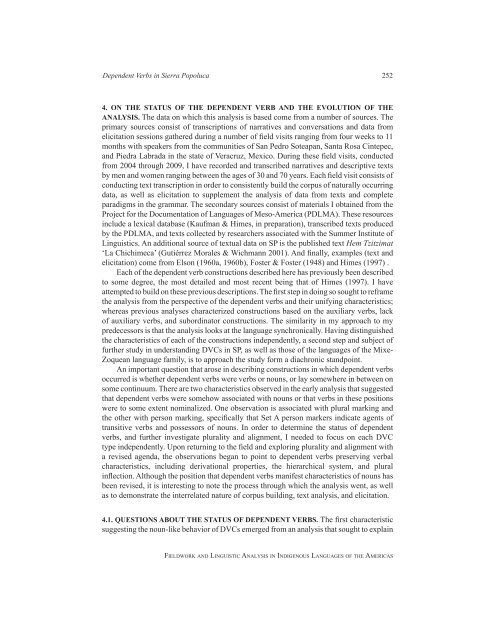Fieldwork and Linguistic Analysis in Indigenous ... - ScholarSpace
Fieldwork and Linguistic Analysis in Indigenous ... - ScholarSpace
Fieldwork and Linguistic Analysis in Indigenous ... - ScholarSpace
You also want an ePaper? Increase the reach of your titles
YUMPU automatically turns print PDFs into web optimized ePapers that Google loves.
Dependent Verbs <strong>in</strong> Sierra Popoluca 252<br />
4. ON THE STATUS OF THE DEPENDENT VERB AND THE EVOLUTION OF THE<br />
ANALYSIS. The data on which this analysis is based come from a number of sources. The<br />
primary sources consist of transcriptions of narratives <strong>and</strong> conversations <strong>and</strong> data from<br />
elicitation sessions gathered dur<strong>in</strong>g a number of field visits rang<strong>in</strong>g from four weeks to 11<br />
months with speakers from the communities of San Pedro Soteapan, Santa Rosa C<strong>in</strong>tepec,<br />
<strong>and</strong> Piedra Labrada <strong>in</strong> the state of Veracruz, Mexico. Dur<strong>in</strong>g these field visits, conducted<br />
from 2004 through 2009, I have recorded <strong>and</strong> transcribed narratives <strong>and</strong> descriptive texts<br />
by men <strong>and</strong> women rang<strong>in</strong>g between the ages of 30 <strong>and</strong> 70 years. Each field visit consists of<br />
conduct<strong>in</strong>g text transcription <strong>in</strong> order to consistently build the corpus of naturally occurr<strong>in</strong>g<br />
data, as well as elicitation to supplement the analysis of data from texts <strong>and</strong> complete<br />
paradigms <strong>in</strong> the grammar. The secondary sources consist of materials I obta<strong>in</strong>ed from the<br />
Project for the Documentation of Languages of Meso-America (PDLMA). These resources<br />
<strong>in</strong>clude a lexical database (Kaufman & Himes, <strong>in</strong> preparation), transcribed texts produced<br />
by the PDLMA, <strong>and</strong> texts collected by researchers associated with the Summer Institute of<br />
<strong>L<strong>in</strong>guistic</strong>s. An additional source of textual data on SP is the published text Hem Tzitzimat<br />
‘La Chichimeca’ (Gutiérrez Morales & Wichmann 2001). And f<strong>in</strong>ally, examples (text <strong>and</strong><br />
elicitation) come from Elson (1960a, 1960b), Foster & Foster (1948) <strong>and</strong> Himes (1997) .<br />
Each of the dependent verb constructions described here has previously been described<br />
to some degree, the most detailed <strong>and</strong> most recent be<strong>in</strong>g that of Himes (1997). I have<br />
attempted to build on these previous descriptions. The first step <strong>in</strong> do<strong>in</strong>g so sought to reframe<br />
the analysis from the perspective of the dependent verbs <strong>and</strong> their unify<strong>in</strong>g characteristics;<br />
whereas previous analyses characterized constructions based on the auxiliary verbs, lack<br />
of auxiliary verbs, <strong>and</strong> subord<strong>in</strong>ator constructions. The similarity <strong>in</strong> my approach to my<br />
predecessors is that the analysis looks at the language synchronically. Hav<strong>in</strong>g dist<strong>in</strong>guished<br />
the characteristics of each of the constructions <strong>in</strong>dependently, a second step <strong>and</strong> subject of<br />
further study <strong>in</strong> underst<strong>and</strong><strong>in</strong>g DVCs <strong>in</strong> SP, as well as those of the languages of the Mixe-<br />
Zoquean language family, is to approach the study form a diachronic st<strong>and</strong>po<strong>in</strong>t.<br />
An important question that arose <strong>in</strong> describ<strong>in</strong>g constructions <strong>in</strong> which dependent verbs<br />
occurred is whether dependent verbs were verbs or nouns, or lay somewhere <strong>in</strong> between on<br />
some cont<strong>in</strong>uum. There are two characteristics observed <strong>in</strong> the early analysis that suggested<br />
that dependent verbs were somehow associated with nouns or that verbs <strong>in</strong> these positions<br />
were to some extent nom<strong>in</strong>alized. One observation is associated with plural mark<strong>in</strong>g <strong>and</strong><br />
the other with person mark<strong>in</strong>g, specifically that Set A person markers <strong>in</strong>dicate agents of<br />
transitive verbs <strong>and</strong> possessors of nouns. In order to determ<strong>in</strong>e the status of dependent<br />
verbs, <strong>and</strong> further <strong>in</strong>vestigate plurality <strong>and</strong> alignment, I needed to focus on each DVC<br />
type <strong>in</strong>dependently. Upon return<strong>in</strong>g to the field <strong>and</strong> explor<strong>in</strong>g plurality <strong>and</strong> alignment with<br />
a revised agenda, the observations began to po<strong>in</strong>t to dependent verbs preserv<strong>in</strong>g verbal<br />
characteristics, <strong>in</strong>clud<strong>in</strong>g derivational properties, the hierarchical system, <strong>and</strong> plural<br />
<strong>in</strong>flection. Although the position that dependent verbs manifest characteristics of nouns has<br />
been revised, it is <strong>in</strong>terest<strong>in</strong>g to note the process through which the analysis went, as well<br />
as to demonstrate the <strong>in</strong>terrelated nature of corpus build<strong>in</strong>g, text analysis, <strong>and</strong> elicitation.<br />
4.1. QUESTIONS ABOUT THE STATUS OF DEPENDENT VERBS. The first characteristic<br />
suggest<strong>in</strong>g the noun-like behavior of DVCs emerged from an analysis that sought to expla<strong>in</strong><br />
fieldwork <strong>and</strong> l<strong>in</strong>guistic analysis <strong>in</strong> <strong>in</strong>digenous languages of the americas

















